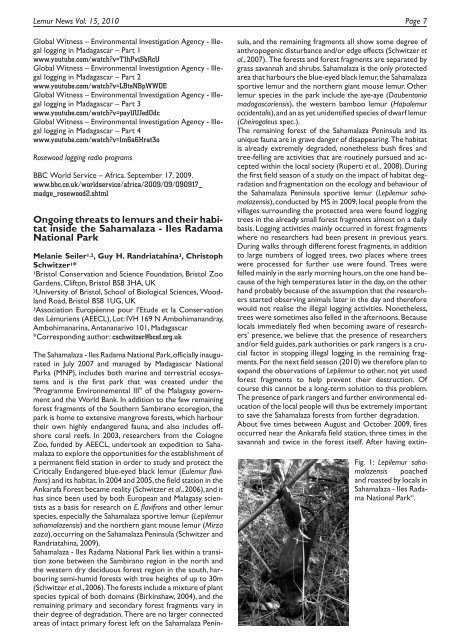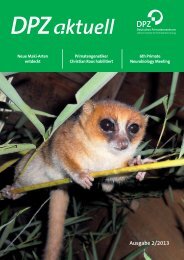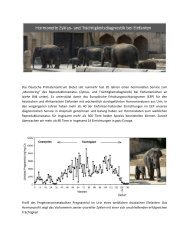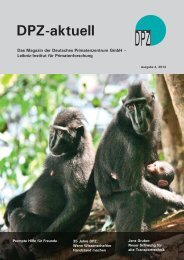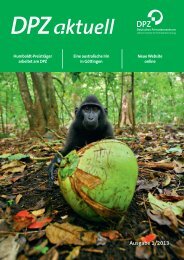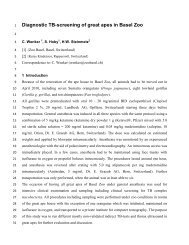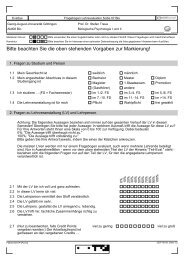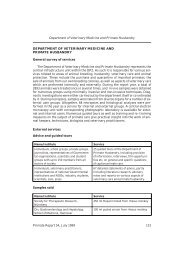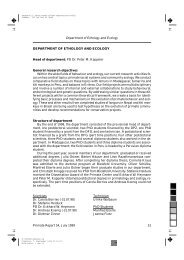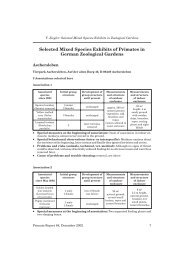Vol. 15 - Deutsches Primatenzentrum
Vol. 15 - Deutsches Primatenzentrum
Vol. 15 - Deutsches Primatenzentrum
Create successful ePaper yourself
Turn your PDF publications into a flip-book with our unique Google optimized e-Paper software.
Lemur News <strong>Vol</strong>. <strong>15</strong>, 2010 Page 7<br />
Global Witness – Environmental Investigation Agency - Illegal<br />
logging in Madagascar – Part 1<br />
www.youtube.com/watch?v=T1hPviSbRcU<br />
Global Witness – Environmental Investigation Agency - Illegal<br />
logging in Madagascar – Part 2<br />
www.youtube.com/watch?v=LBtsNBpWW0E<br />
Global Witness – Environmental Investigation Agency - Illegal<br />
logging in Madagascar – Part 3<br />
www.youtube.com/watch?v=payUUJed0dc<br />
Global Witness – Environmental Investigation Agency - Illegal<br />
logging in Madagascar – Part 4<br />
www.youtube.com/watch?v=lm6a6Hrat3o<br />
Rosewood logging radio programs<br />
BBC World Service – Africa. September 17, 2009.<br />
www.bbc.co.uk/worldservice/africa/2009/09/090917_<br />
madge_rosewood2.shtml<br />
Ongoing threats to lemurs and their habitat<br />
inside the Sahamalaza - Iles Radama<br />
National Park<br />
Melanie Seiler 1,2, Guy H. Randriatahina 3, Christoph<br />
Schwitzer 1*<br />
1Bristol Conservation and Science Foundation, Bristol Zoo<br />
Gardens, Clifton, Bristol BS8 3HA, UK<br />
2University of Bristol, School of Biological Sciences, Woodland<br />
Road, Bristol BS8 1UG, UK<br />
3Association Européenne pour l’Etude et la Conservation<br />
des Lémuriens (AEECL), Lot: IVH 169 N Ambohimanandray,<br />
Ambohimanarina, Antananarivo 101, Madagascar<br />
*Corresponding author: cschwitzer@bcsf.org.uk<br />
The Sahamalaza - Iles Radama National Park,officially inaugurated<br />
in July 2007 and managed by Madagascar National<br />
Parks (MNP), includes both marine and terrestrial ecosystems<br />
and is the first park that was created under the<br />
"Programme Environnemental III" of the Malagasy government<br />
and the World Bank. In addition to the few remaining<br />
forest fragments of the Southern Sambirano ecoregion, the<br />
park is home to extensive mangrove forests, which harbour<br />
their own highly endangered fauna, and also includes offshore<br />
coral reefs. In 2003, researchers from the Cologne<br />
Zoo, funded by AEECL, undertook an expedition to Sahamalaza<br />
to explore the opportunities for the establishment of<br />
a permanent field station in order to study and protect the<br />
Critically Endangered blue-eyed black lemur (Eulemur flavifrons)<br />
and its habitat.In 2004 and 2005,the field station in the<br />
Ankarafa Forest became reality (Schwitzer et al.,2006),and it<br />
has since been used by both European and Malagasy scientists<br />
as a basis for research on E. flavifrons and other lemur<br />
species, especially the Sahamalaza sportive lemur (Lepilemur<br />
sahamalazensis) and the northern giant mouse lemur (Mirza<br />
zaza),occurring on the Sahamalaza Peninsula (Schwitzer and<br />
Randriatahina, 2009).<br />
Sahamalaza - Iles Radama National Park lies within a transition<br />
zone between the Sambirano region in the north and<br />
the western dry deciduous forest region in the south, harbouring<br />
semi-humid forests with tree heights of up to 30m<br />
(Schwitzer et al.,2006).The forests include a mixture of plant<br />
species typical of both domains (Birkinshaw, 2004), and the<br />
remaining primary and secondary forest fragments vary in<br />
their degree of degradation. There are no larger connected<br />
areas of intact primary forest left on the Sahamalaza Penin-<br />
sula, and the remaining fragments all show some degree of<br />
anthropogenic disturbance and/or edge effects (Schwitzer et<br />
al., 2007). The forests and forest fragments are separated by<br />
grass savannah and shrubs. Sahamalaza is the only protected<br />
area that harbours the blue-eyed black lemur,the Sahamalaza<br />
sportive lemur and the northern giant mouse lemur. Other<br />
lemur species in the park include the aye-aye (Daubentonia<br />
madagascariensis), the western bamboo lemur (Hapalemur<br />
occidentalis),and an as yet unidentified species of dwarf lemur<br />
(Cheirogaleus spec.).<br />
The remaining forest of the Sahamalaza Peninsula and its<br />
unique fauna are in grave danger of disappearing.The habitat<br />
is already extremely degraded, nonetheless bush fires and<br />
tree-felling are activities that are routinely pursued and accepted<br />
within the local society (Ruperti et al., 2008). During<br />
the first field season of a study on the impact of habitat degradation<br />
and fragmentation on the ecology and behaviour of<br />
the Sahamalaza Peninsula sportive lemur (Lepilemur sahamalazensis),<br />
conducted by MS in 2009, local people from the<br />
villages surrounding the protected area were found logging<br />
trees in the already small forest fragments almost on a daily<br />
basis. Logging activities mainly occurred in forest fragments<br />
where no researchers had been present in previous years.<br />
During walks through different forest fragments, in addition<br />
to large numbers of logged trees, two places where trees<br />
were processed for further use were found. Trees were<br />
felled mainly in the early morning hours,on the one hand because<br />
of the high temperatures later in the day, on the other<br />
hand probably because of the assumption that the researchers<br />
started observing animals later in the day and therefore<br />
would not realise the illegal logging activities. Nonetheless,<br />
trees were sometimes also felled in the afternoons. Because<br />
locals immediately fled when becoming aware of researchers’<br />
presence, we believe that the presence of researchers<br />
and/or field guides, park authorities or park rangers is a crucial<br />
factor in stopping illegal logging in the remaining fragments.For<br />
the next field season (2010) we therefore plan to<br />
expand the observations of Lepilemur to other, not yet used<br />
forest fragments to help prevent their destruction. Of<br />
course this cannot be a long-term solution to this problem.<br />
The presence of park rangers and further environmental education<br />
of the local people will thus be extremely important<br />
to save the Sahamalaza forests from further degradation.<br />
About five times between August and October 2009, fires<br />
occurred near the Ankarafa field station, three times in the<br />
savannah and twice in the forest itself. After having extin-<br />
Fig. 1: Lepilemur sahamalazensis<br />
poached<br />
and roasted by locals in<br />
Sahamalaza - Iles Radama<br />
National Park“.


